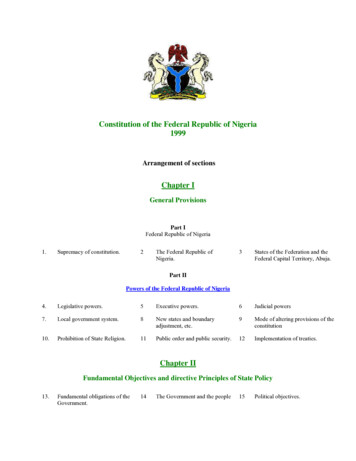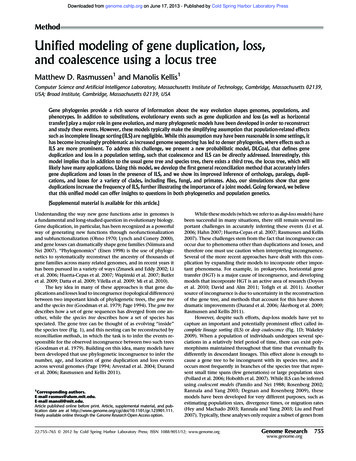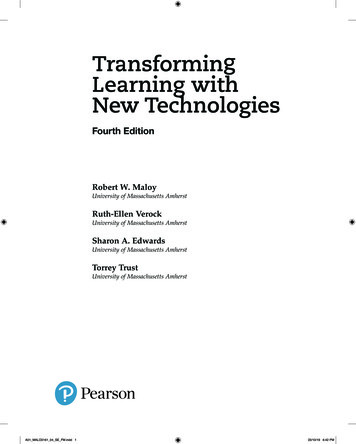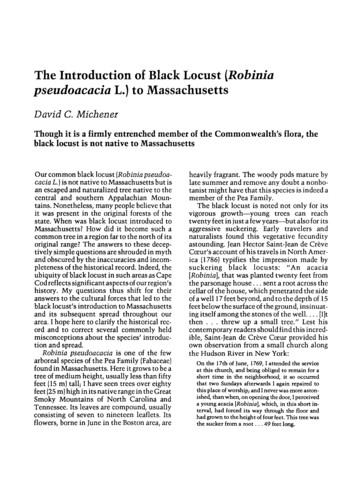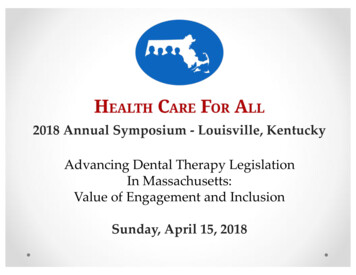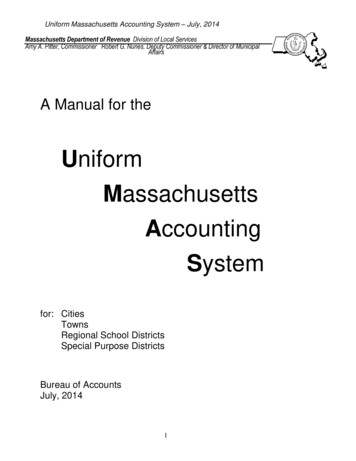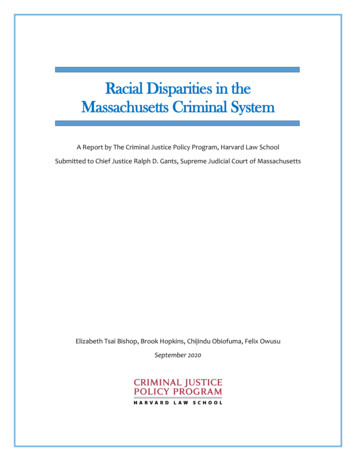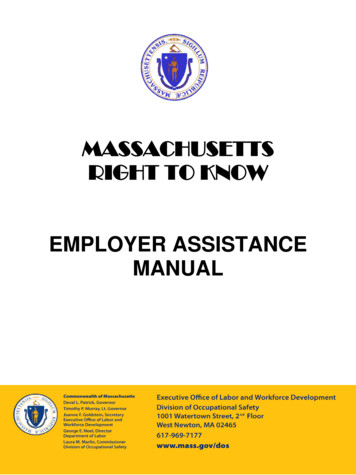
Transcription
MASSACHUSETTSRIGHT TO KNOWEMPLOYER ASSISTANCEMANUAL
Massachusetts Right To Know Employer Assistance ManualMASSACHUSETTS RIGHT TO KNOWEMPLOYERASSISTANCE MANUALCommonwealth of MassachusettsExecutive Office of Labor and Workforce DevelopmentDepartment of LaborDivision of Occupational SafetyPrepared and updated by the Division of Occupational Safety’sWorkplace Safety and Health ProgramIf you have any questions or would like additional copies contact:Division of Occupational SafetyMassachusetts Workplace Safety and Health Program1001 Watertown Street, 2nd FloorWest Newton, MA 02465(617) 969-7177www.mass.gov/dos/rtkPage 2
Massachusetts Right To Know Employer Assistance ManualPage 3MASSACHUSETTS RIGHT TO KN0W EMPL0YER ASSISTANCE MANUALTABLE OF CONTENTSINTRODUCTION.4SECTION I: OVERVIEW OF THE MASSACHUSETTS RIGHT TO KNOW LAWWhat is the Right to Know Law?.Which Workplaces are Regulated by the Right to Know Law?. Which Products are Covered?.Which Products are Exempt?.What are Employers Required to do?.Recommended Right to Know Tasks.6778910SECTION II: HELP MODULES1Getting Started . .2Conducting the Right to Know Inventory . .3Fulfilling Your Material Safety Data Sheet (MSDS) Requirements .4Container Labeling . .5Employee Training. .6Recordkeeping and Ongoing Tasks. .142223354051SECTION III: GOVERNMENTAL DUTIES and ENFORCEMENT of the MASSACHUSETTSRIGHT TO KNOW LAWDuties of Governmental Agencies .54-56Enforcement and Penalties .54-56SECTION IV: APPENDICESA. Government Agencies . .B. Right To Know Workplace Notice. C. How to Obtain Massachusetts Right to Know Documents . D. Index to Right to Know Law . . E. Directory of Private Agencies and Organizations . .F. References for a Safer and Healthier Workplace .G. Municipal Right to Know Fact Sheet. .H. Massachusetts Substance List . .I. MSDS Criteria Sheet . .5859-6061626467697071List of FiguresFigure 1: Product Inventory Sheet .Figure 2: Access to MSDSs: Employees. . . Figure 3: Sample Material Safety Data Sheet (MSDS) Form . .Figure 4: Sample Labels Figure 5: National Fire Protection Association (NFPA) Label .172930-343738
Massachusetts Right To Know Employer Assistance ManualPage 4INTRODUCTIONThe Division of Occupational Safety has written this Right to Know Employer AssistanceManual for you, the employer. It is especially geared for state agency managers, townadministrators and community college managers. The Manual is not intended to be asubstitute for reading the law, but rather to serve as a companion guidebook to the law. TheManual offers a step-by-step explanation of the legal and technical issues involved withfulfilling the workplace requirements under the Right to Know Law. It also includes updatedinformation on DOS’s Alternative Policy on compliance with the Massachusetts’ Right toKnow Law.NOTE: This Manual is intended to provide public sector employers with information on howto comply with the workplace components of the law (sections 7-11, 13-15 of MGL, Ch.111F) and workplace regulations (454 CMR 21.00), as well as applicable policies.The Massachusetts Right to Know Law serves to protect the health of public sectoremployees. It does this by directing employers to communicate to their employees,information on hazardous or toxic substances in the workplace. Fundamentally, theresponsibility for gathering and disseminating this information to employees restsprimarily with you, the employer.The Manual reviews all of the workplace requirements under this law and providesdetailed guidelines and special tips on how to most effectively use the resources youhave available. It will provide the information you need to set up and maintain yourworkplace Right to Know Program.The Manual is organized so that you can use it easily and quickly to get the information youneed. It is divided into four sections. The first two sections provide an overview of the lawand detailed information on how to fulfill your responsibilities. The third section reviews thefunctions of the state agencies responsible for implementing the law and where to turn forfurther assistance. It also reviews the Division of Occupational Safety’s enforcementactivities and the penalty provisions of the Right to Know Law. The final section consists ofappendices, which contain supporting information that is referenced throughout theManual.For further technical assistance, the Division of Occupational Safety can assist you inmeeting the requirements of the law. The Division's services are provided at no cost.
Massachusetts Right To Know Employer Assistance ManualPage 5A. WHAT IS THE RIGHT TO KNOW LAW?The Massachusetts Right to Know Law (Massachusetts General Laws, Chapter 111F) wassigned by Governor Michael Dukakis in November 1983 and became effective September26, 1984. The law requires manufacturers to supply public sector employers and publicsector employers to provide public employees, with information on the toxic and hazardoussubstances in their workplaces. In certain circumstances, public employers will alsoindirectly supply this information to community residents, medical personnel and other stateand local officials. There are approximately 1600 substances defined as toxic or hazardousunder the law. This official list of regulated substances is called the MassachusettsSubstance List (see Appendix I).It is hoped that informed public employees and their employers will make betterdecisions regarding work operations that involve hazardous chemicals. Publicemployees will be more able to recognize hazardous situations at work, and eithercorrect the situation themselves (if possible), or alert and work with their employer.Under the Massachusetts Right to Know Law, communication of information toemployees is accomplished in three ways:1. Material Safety Data Sheets or MSDSs: These brief documents, obtainedfrom manufacturers and suppliers of toxic and hazardous substances, are theprimary sources of information under the law. They include information suchas chemical identity, physical properties, health and safety hazards, safehandling procedures, and spill, leak and disposal procedures. For anexample of an MSDS, see Figure 4, p. 31-34.2. Container Labels: The chemical contents of certain containers must appearon the label. Ideally, the label alerts workers and supervisors to the presenceof toxic or hazardous chemicals. Also, such information is useful to anemployee's physician, workplace health and safety committee, etc.3. Employee Training: Employers must provide annual training to employeeson the hazards and safe handling procedures of regulated substances in theworkplace. New employees must also be trained within thirty days ofemployment.If you, the employer, implement a workplace Right to Know program that integratesthese three methods of communication, it will be an effective way of protecting thehealth of employees who work with hazardous products.
Massachusetts Right To Know Employer Assistance ManualB.Page 6WHICH WORKPLACES ARE REGULATED BY THE RIGHT TO KNOW LAW?When the Massachusetts Right to Know Law originally went into effect on September 26,1984, it covered most workplaces in Massachusetts. However, the Federal OccupationalSafety and Health Administration (OSHA) has issued its own Hazard CommunicationStandard (CFR 1910.1200). This standard applies to employers in the private sector. Itpreempts the workplace portions of the Massachusetts Right to Know Law in that sector. Manufacturers in all states who supply toxic or hazardous substances to publicemployers in Massachusetts must provide them with Material Safety Data Sheets(MSDSs). MSDSs must meet the standards of the Massachusetts Right to Know Law (seeAppendix J).There are some exclusions, although narrow in scope, based on the nature of theworkplace operations. They are as follows:1. Research Laboratories: Exemption from Right to Know coverage is available topublic sector research laboratories only by applying to the MassachusettsDepartment of Public Health. A research lab is defined as:"any workplace or work area of a workplace used primarily for research,development, non-routine testing or experimentation activity in which toxic orhazardous substances are used by or under the direct supervision of atechnically qualified individual. Provided, however, that a research laboratoryshall not be involved in the production or manufacture of goods for directcommercial sale."Even if exempt, public research laboratories must still ensure that workers are fullyinformed of the hazards and safe handling procedures for regulated chemicals.
Massachusetts Right To Know Employer Assistance ManualPage 72. The Massachusetts Right to Know (RTK) Law does not cover Police Stations andArmories where ammunition is stored.3. The Massachusetts RTK Law does not cover workplaces operated by thefederal government.For all other public sector employers, the Massachusetts RTK Law applies. But itsapplicability, of course, depends on whether regulated substances are used or stored in theworkplace.C. WHICH PRODUCTS ARE COVERED?In general, the Massachusetts RTK Law covers all products that contain any of the toxic orhazardous substances on the Massachusetts Substance List (MSL) in regulated amounts.(For more information on the MSL, see Appendix I.) There are currently over 1600substances on the MSL.
Massachusetts Right To Know Employer Assistance ManualPage 8D. WHICH PRODUCTS ARE EXEMPT?There are some major exemptions, which have been granted under the law andregulations. The Commissioner of the Division of Occupational Safety has the power togrant additional exemptions.1.Consumer Products Consumer products are exemptfrom the law if:a. they do not contain any carcinogens, teratogens, mutagens,neurotoxins or extraordinarily hazardous substances, andb. they are not required to be labeled under section 7 of the law, andc. they are used in the workplace in such a manner that employees areexposed at a level equivalent to exposures resulting from consumerusage.The second determination you must make is whether the product is being used in yourworkplace in such a manner that the employees are exposed at a level greater than that ofconsumer usage.2.Office SuppliesAll office supplies that are found in an office environment are exempt,including materials used in photographic and copying machines, if:a.the amount of the toxic or hazardous substance found in officesupplies is equivalent to amounts and forms available to consumers, andb.they are used in the workplace in such a manner thatemployee exposure is equivalent to consumer exposure.12Food StuffsGasoline, Oils and Other AdditivesThese products are exempt if:a. they are in fuel tanks, engines and other operating systems of cars orlight duty trucks, and
Massachusetts Right To Know Employer Assistance ManualPage 9b.the substances are present in amounts and forms available toconsumers, andc.they are used in such a manner that employee and environmentalexposure is equivalent to consumer usage.5. Fuel Oils, Natural Gas, Kerosene, Petroleum or PropaneThese products are exempt if:a.b.they are used for space heating or power generation purposes, andemployees are not exposed to fumes or combustion by-products, andall required emission control equipment is used.6. Alcoholic Beverages7. Articles: Finished products or manufactured items.These products are exempt if:a.b.c.they are formed to a specific shape or design during manufacture, andtheir end use function is dependent on its end use design or shape, andthey have no change of chemical composition during end use.E. WHAT ARE EMPLOYERS REQUIRED TO DO?As an employer, you must determine if there are any toxic or hazardous substances used inyour workplace. It is important to designate an individual to be in charge of your program.The following outline assumes that there are regulated substances in your workplace. Itprovides you with a list of the responsibilities and the corresponding module in this manual.
Massachusetts Right To Know Employer Assistance ManualP a g e 10Recommended Right to Know TasksRIGHT TO KNOW TASKSWHERE TO GET HELP1.Appoint a Workplace RTK CoordinatorHelp Module 1: "Getting Started",2.Obtain a Copy of the RTK Law & Regulationsp. 133.Post Workplace Notice(s)4.Determine Which Substances in Your Workplaceare RegulatedDOS website: www.mass.gov/dos;or call DOS for a -------------------------------Help Module 2: "Conducting theRight to Know ------------------------------------5.Obtain MSDSs for Regulated Substancesfrom Suppliers6.Review MSDSs for Completeness7.Establish Procedures for Employees (MSDS)and Others to Obtain MSDSsHelp Module 3: "Fulfilling YourData Sheet ---------------------------------------8.Label Workplace Containers with ChemicalName(s)-of Contents and, if Applicable, theNFPA CodeHelp Module 4: “Container -------------------------------------9.Train Employees Annually on EmployeeRights, How to Read an MSDS, andSpecific Employee Workplace Hazards.Help Module 5: “Employee -------------------------------------10.Maintain a File of MSDSs11.Keep Records of Training12.Keep the Entire RTK Program accurate andup-to-date in Your WorkplaceHelp Module 6: "Record keepingAnd Ongoing Tasks"
Massachusetts Right To Know Employer Assistance ManualSECTION IIHELP MODULESP a g e 11
Massachusetts Right To Know Employer Assistance ManualP a g e 12While at first it may seem that there are many tasks involved, with some organization andpersistence you will get these tasks accomplished. By following the suggestions andstrategies in this Manual, your job will be made easier. One key element of a successfulRight to Know program is getting started on the right track. Three important tasks shouldbe accomplished at the onset:A. appoint a Right to Know Coordinator.B. obtain and review the Right to Know (RTK) Law and Regulations,C. post the Right to Know Workplace Notice.A. APPOINT A RIGHT TO KNOW COORDINATORIt is recommended that one person be assigned the responsibility for developing andimplementing your Right to Know program. In a small workplace, this person may be ableto carry out all the Right to Know compliance tasks in addition to his or her regularfunctions. In a large workplace, the Right to Know Coordinator should be a full-time healthand safety staff person (e.g., an industrial hygienist, health educator, occupational healthnurse).The Right to Know Coordinator should be familiar with the workplace and managementstructure. The Coordinator should have expertise in workplace health and safety and be ableto enlist the assistance of safety personnel, line supervisors, company nurses or physicians,workplace safety committees, union safety representatives, private consultants, stateagencies, etc. (see Directory of Assistance, Appendix A).B. OBTAIN AND REVIEW THE LAW AND REGULATIONSThe Right to Know Law and Regulations are available to the public (to order, see AppendixC). It is important that all employers have these documents, for they contain the officialrequirements employers must fulfill. This guidebook can help you understand theserequirements if you use it in conjunction with the law and regulations. (An index of the Rightto Know Law is presented in Appendix D.)C. POST WORKPLACE NOTICESA Right to Know Workplace Notice must be posted in English in a central location, e.g. thelunch room, near a time clock, on a workplace bulletin board, etc. A copy of the EnglishWorkplace Notice is provided in Appendix B. If any employee speaks a language otherthan English, a Workplace Notice in that language; if available, must also be posted.
Massachusetts Right To Know Employer Assistance ManualP a g e 13Workplace notices are currently available in the following languages from the Division ofOccupational Safety:English, SpanishTo obtain these Notices, call or write to this agency:Division of Occupational Safety1001 Watertown Street WestNewton, MA 02465(617) 969-7177or go to the DOS website, www.mass.gov/dos (English version only).You are now prepared to proceed with the next step in your Right to Know program: toconduct an inventory of the chemical substances in your workplace to determine whichones are regulated. You may find through this process that regulated substances are notused or stored in your workplace. In that case, there is no need for a person to serve asRight to Know Coordinator, and Right to Know Notices need not be posted. Be aware,however, that you must determine if new products entering your workplace are regulated,or if amendments to the Massachusetts Substance List change the regulatory status ofsubstances in your workplace (see Help Module 6, "Recordkeeping and Ongoing Tasks",p.50).
Massachusetts Right To Know Employer Assistance ManualP a g e 14You cannot know your obligations under the Right to Know (RTK) Law until you conduct aninventory of the products that are used or stored in your workplace. While your purchasingdepartment can help by supplying a list of purchased products, it should not substitute foran on-site survey of the products in your workplace. This will ensure that all products (suchas cleaning supplies) are recorded in your inventory. Your next step is to determine whichof your workplace products are covered under the law. This determination is made bycomparing the chemical names and percent composition of ingredients of workplaceproducts with the Massachusetts Substance List (MSL). The MSL is the official list of alltoxic or hazardous substances regulated by the law.If a product in your workplace contains one or more toxic or hazardous ingredients listed onthe MSL and is present at concentrations of at least 1% (2% if an impurity), that product isregulated by the RTK law. There is another class of substances called "ExtraordinarilyHazardous Substances". If a substance is on this much smaller sub-list, it is regulated at aconcentration of one ten-thousandth of one percent (or one part per million). For furtherinformation on the Massachusetts Substance List, see Appendix I.A. WORKPLACE PRODUCT INVENTORYFor each product used or stored in your workplace, it is important for you to record asmuch information as possible. Suggestion: Use the Product Inventory Sheet (Figure 1.p. 18).The following is a list of each item on the Product Inventory Sheet and an explanation of itsusefulness.1. Product (trade or common) Name:The product name is the name that is often most prominent on the label andthe one that is listed in catalogs and used when making a purchase. Theproduct name of the substance should not be confused with the chemicalname(s) of the ingredient(s). If the product is made up of only onechemical, then the product name and chemical name may be
Massachusetts Right To Know Employer Assistance ManualP a g e 15identical. You will need to use the product name when you requestMaterial Safety Data Sheets (MSDS) from the manufacturer. (For asample MSDS, see Figure 4. p. 31)2. Manufacturer's (or Supplier's) Name and Address:This information identifies the source of the product as well as where towrite when requesting Material Safety Data Sheets.3. Container Size (By Weight or Volume):This information is necessary to determine labeling requirements (seeHelp Module 4, p.35).4. Chemical Ingredients:Unless you are using the alternative policy given on page 15, the chemicalnames of ingredients are needed to cross-match with the MassachusettsSubstance List (MSL) in order to determine if the product is regulated by theRTK, Law. This information may be obtained from product labels or a MaterialSafety Data Sheet (MSDS).5. Percent Composition (of Each Ingredient in the Mixture):This will determine if an MSL substance in a product meets or exceeds thepercentage requirements of the law. The concentration of a hazardousingredient in a mixture can indicate how hazardous a material may be. Insome instances this information is found on the product label, but generallyyou will have to get it from the MSDS.6. Chemical Abstract Service (CAS) Number:This is a number that is assigned to every pure chemical. It is helpful to havewhen checking the MSL since both chemical name and CAS number
Massachusetts Right To Know Employer Assistance ManualP a g e 16index the MSL. Unfortunately, CAS numbers are often not found on thelabel, but should be found in most cases on the MSDS.7.Work Location - areas where products are manufactured, processed, used orstored:Location can be useful when designing a training program that will informworkers where hazardous materials may be encountered.8.How The Product Is Used:This information can help you in your training and also help you determine if asafer, but equally effective, product can be substituted.
Massachusetts Right To Know Employer Assistance ManualP a g e 17
Massachusetts Right To Know Employer Assistance ManualP a g e 18B. POSSIBLE INVENTORY PROBLEMSIn conducting your product inventory, you may have some difficulty collecting theinformation. The following section will explain how to deal with some of these problems.1. Chemical TermsThe following chemical terms may be useful to you when conducting theinventory.a. Mixture vs. Pure SubstanceAn important concept is the difference between a mixture and a puresubstance. A mixture contains two or more ingredients’ whereas a puresubstance is made up of only one material. Each pure substance has its owncharacteristics. When the pure substances are blended together into amixture, the mixture as a whole will have unique characteristics that are acombination of the properties of the individual ****Example: A paintbrush cleaner called “XXX” is a mixture. It is made up of benzene,toluene, xylene, acetone and methyl alcohol - five pure substances. The characteristics ofthe paintbrush cleaner will be a combination of the properties of the ingredients. On theother hand, a pure substance could be called “YYY” and be made up of 100% ************b. Chemical Name vs. Product (trade) nameIn the above examples, the product names are “XXX” and “YYY”. However,you will need to use the chemical names of the ingredients in these productswhen determining if they are on the Massachusetts Substance List (MSL).The chemical name of “Spot-B-Gone” is carbon tetrachloride and “Like-Nu”has five ingredients whose chemical names are benzene, toluene, xylene,acetone and methyl alcohol. You will know if the law regulates theseproducts if the chemical names of any of their ingredients are on the MSL.The product name is used when writing to the supplier or manufacturer for aMaterial Safety Data Sheet (MSDS).c. Chemical Family Name vs. Individual Chemical NameProduct labels and MSDSs often give the family name or generic term for theingredients. This term does not give you the exact content of the
P a g e 19Massachusetts Right To Know Employer Assistance Manualproduct because it refers to a group of chemicals. Examples of familygroups that may be found on labels or MSDSs are:- halogenated hydrocarbons- aliphatic hydrocarbons- aromatic hydrocarbons- epoxy compounds- phenols and their compounds- pigments- metallic compounds- alcohols- ketones- aldehydes- solvents- acids- resins- ethers- cyanatesIf the label supplies one of these family names and not the exact name of theindividual chemical, you will not be able to determine if it is regulatedbecause the Massachusetts Substance List (MSL) lists only chemicalnames. You will then have to obtain an MSDS on the ********Example: Solvent is the name for a group of chemicals that are degreasing agents.Methylene chloride is the name of a pure chemical that is a solvent.Methylene chloride is listed on the ****2. Obtaining the Chemical Names and Percent Composition of IngredientsIt is sometimes possible with pure chemicals to get the chemical name fromthe container label. This is often true of products found in labs. In mixtures, itis less likely that the product label will provide you with all the chemicalingredients and their percent composition. If you have any doubt aboutwhether the label has provided complete information, it is stronglyrecommended that you get this information from a Material Safety Data Sheet(MSDS). (See Help Module 3 for assistance on how to obtain MSDSs.) Onceyou have all the information, you will be ready to determine which of yourproducts are covered by the law (see p. 8).3. Determining the Name and Address of the ManufacturerIf the container has a label with the product name but lists no manufactureror supplier, first check to see if the purchasing department has a record forthat product. If no one in your workplace has any information, call theChemical Manufacturers Association toll-free at 1-800-262-8200 or atwww.cma.com for assistance.4. No Label on a ProductOver time the label may wear out or fall off the container. Your first stepwould be to see if there are any old inventories that would identify theproduct. Ask the employees who use the product if they have anyinformation. The purchasing department may also have some records on
Massachusetts Right To Know Employer Assistance ManualP a g e 20the product. As a last resort, you may have to have the product tested todetermine its chemical ingredients. Only re-label a container if you canpositively identify it. You must affix a suitable label as soon as possible.However, if it is a product that is no longer in use you may dispose of it, butmake sure you follow state and federal hazardous waste regulations.C.HOW TO DETERMINE WHICH PRODUCTS ARE REGULATEDYou need to know the chemical ingredients of products before you can determinewhich products are regulated. You may be able to get this information from the labelif the label provides you with the names of all of the ingredients in the product. Formost products you will have to obtain the MSDS to find out exactly what is in it (seeHelp Module 3 on how to obtain MSDSs). After you know the chemical ingredients inyour workplace products, you are ready for the following steps:1Compare the chemical names of ingredients of the product with those listedon the most current version of the Massachusetts Substance List (MSL). If you havethe Chemical Abstract Service number (CAS #) for the ingredients, you can also useit when checking the MSL. Both chemical name and CAS index the MSL #. In fact, ifavailable, it is better to use the CAS # because the name on the MSDS may not belisted as such on the MSL. Make a notation if a chemical ingredient is listed on theMSL. Also, be sure to identify those ingredients that are classified as "ExtraordinarilyHazardous Substances" (see Appendix I). If you have any problems or needassistance, see Appendix A.2Determine if MSL ingredients are present at levels equal to or greater thanminimum regulated concentrations, as follows: If the concentration of one or moreMSL ingredients in a particular product equals or exceeds the following levels, theproduct is regulated under the RTK Law.-Listed MSL Substance: 1% or, if it is an impurity, 2%-Extraordinarily Hazardous Substances: 1 ppm, equal to one tenthousandth of one percent3.Compile a separate "Workplace Right to Know Substance List" thatidentifies the regulated substances in your workplace. The RTK requirementsfor regulated substances are given in subsequent Help Modules of this manual.
Massachusetts Right To Know Employer Assistance ManualP a g e 21As stated earlier, some of the MSL substances in your workplace may be exemptfrom coverage under the Right to Know Law. Exemptions, listed on page 8, shouldbe reviewed before proceeding with your RTK compliance efforts.
Massachusetts Right To Know Employer Assistance ManualP a g e 22Under the Massachusetts Right to Know Law, Material Safety Data Sheets (MSDSs) are theprimary means of co
The Massachusetts Right to Know Law (Massachusetts General Laws, Chapter 111F) was signed by Governor Michael Dukakis in November 1983 and became effective September 26, 1984.

